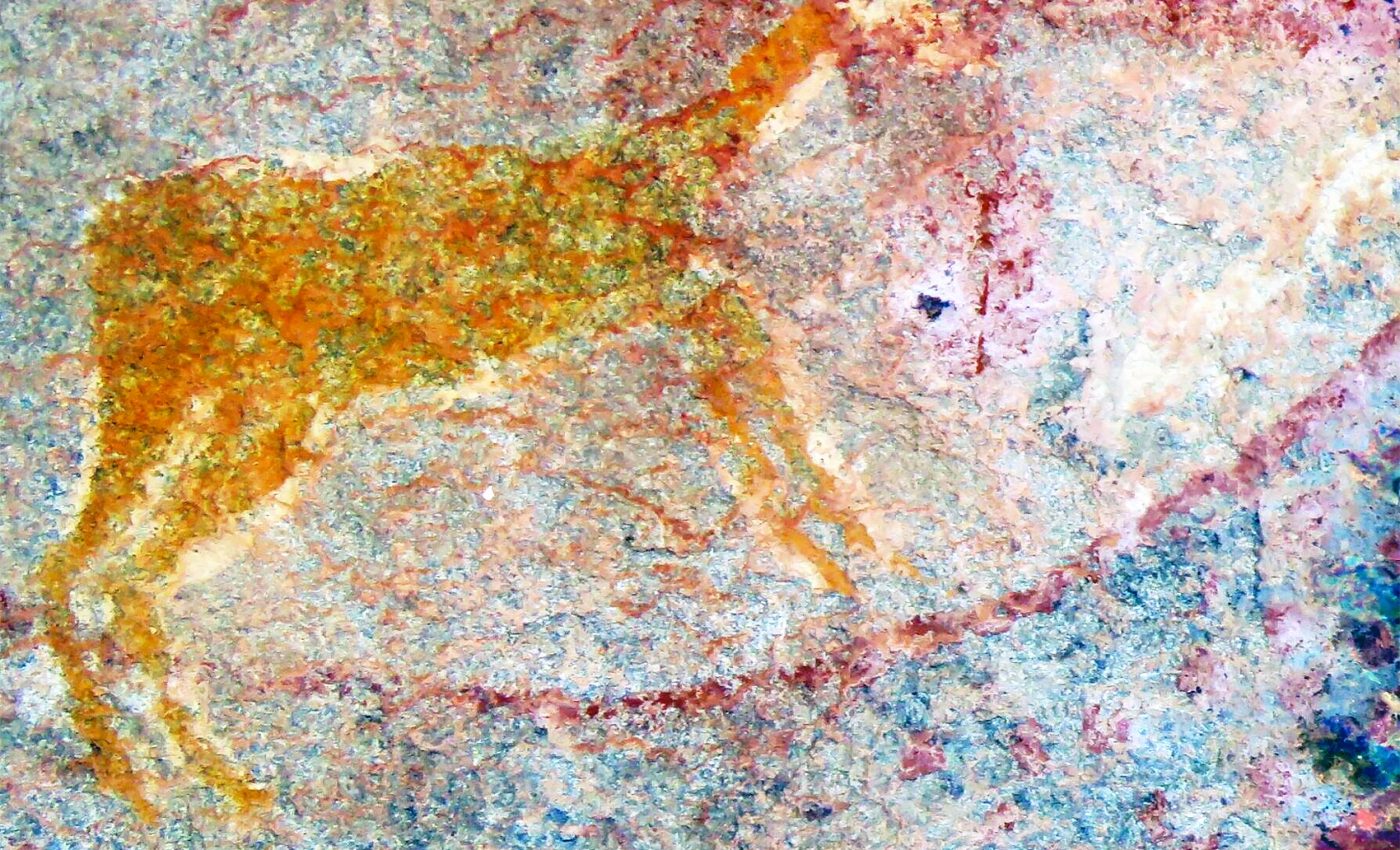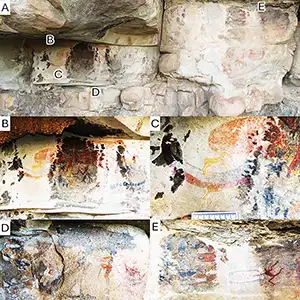
Cave art discovery depicts an animal that went extinct 280-million-years ago, baffling scientists
The Karoo stretches across more than 150,000 square miles of semi-arid South Africa, a place where sun-bleached soil keeps secrets older than dinosaurs. Wander its stony flats and you’ll see ridges of exposed rock that look like the pages of a giant book.
The “chapters” span hundreds of millions of years, each one packed with fossilized bone and impressions of vanished forests. For anyone fascinated by life’s backstory, the Karoo is irresistible.
Long before geology students arrived with measuring tapes and plaster, Indigenous families lived among those same outcrops.
The San, sometimes called the /Xam, camped at waterholes, painted hunting scenes on sandstone walls, and passed down tales of shape-shifting serpents that brewed thunderstorms.
Their art survives in shallow caves and overhangs, capturing the everyday and the uncanny with equal care.
Dicynodont art painted in caves
The Karoo’s fossil fame rests on creatures named dicynodonts – chunky plant-eaters about the size of pigs, sporting a beak and two downward-pointing tusks.
They ruled the Permian Period more than 250 million years ago, well before the first dinosaur hatched.
Because the region is dry and wind-scoured, dicynodont skulls often erode straight out of hillsides; a passerby can spot the ivory-colored bone from yards away.
It’s not hard to imagine early herders stumbling upon those skulls and weaving them into local lore.
The San also left thousands of charcoal and ochre paintings. Some show antelope and giraffes, others depict trance dances where healers slip into the spirit world.
Among the most intriguing images appears on a wall known as the Horned Serpent panel, created between 1821 and 1835.
One painted figure stretches like a slender crocodile but displays a pair of tusks that bend toward the ground – no living African animal matches that appearance.
Tusks on the rock wall
When researchers first cataloged the panel, they guessed the creature might be a rain-making spirit. That interpretation fit San cosmology, where serpents often control clouds.
Yet even a mythic animal usually borrows details from reality: hoof shapes, horn curls, or in this case, tusks. The puzzle lingered for decades.
A fresh investigation recently took a different angle.

After carefully comparing the painted outline with dozens of Karoo fossils, a paleontologist noticed striking overlap – head shape, tusk angle, and body proportions mirrored those of a typical dicynodont skeleton.
The artist seems to have sketched what looks like a fossil skull still embedded in rock, then fused it with a serpent’s sinuous torso.
Searching for answers
The idea gains strength from archaeology. Dig sites near San shelters have yielded chipped stone tools alongside fossil fragments carried from distant outcrops.
That means people collected ancient bones, perhaps as curios or ritual objects.
Oral traditions recorded in the late 1800s even speak of colossal beasts that once walked the land before “the ground dried and cracked.” Those tales echo the fossil record’s story of extinction during the end-Permian mass die-off.
If the cave art painting really captures a dicynodont, it predates formal paleontology. Western science first named a species in 1845, yet the Horned Serpent panel was finished no later than 1835.

“The painting was made in 1835 at the latest, which means this dicynodont was depicted at least ten years before the western scientific discovery and naming of the first dicynodont by Richard Owen in 1845,” noted Julien Benoit of the University of the Witwatersrand, author of this study.
“This work supports [the fact] that the first inhabitants of southern Africa, the San hunter-gatherers, discovered fossils, interpreted them and integrated them in their rock art and belief system.”
Deciphering the dicynodont art
Benoit and colleagues photographed the panel under varying light, traced outlines digitally, and matched them with museum specimens.
The correlation, they argue, is too tight to be chance. Their work joins a handful of cases worldwide – China, Australia, North America – where Indigenous art may double as the earliest depiction of extinct animals.
The research also nudges scientists to widen their lens. Fossil discovery stories often center on explorers in pith helmets, but communities living alongside outcrops have noticed, collected, and wondered about old bones for millennia.
Recognizing that legacy broadens the history of paleontology and honors knowledge systems that predate universities.
Why does any of this matter?
Beyond scholarly credit, the find invites fresh partnerships. Rock art sites need protection from erosion, vandalism, and mining.
By linking paintings to fossils, heritage managers can argue for preserving whole landscapes rather than isolated walls. That approach safeguards both cultural memory and the deep-time record locked in nearby strata.
The study also sparks questions for educators. Imagine guiding school groups to a shelter where a dicynodont skull rests at the foot of a painted serpent.
Students could trace a line from 250-million-year-old mud to a 19th-century brushstroke, then to modern CT scans revealing bone microstructure.
Such encounters make earth science tangible and show that curiosity about ancient life is a shared human trait, not an imported discipline.
How is this dicynodont art possible?
Evidence that the San looked at fossils and painted what they saw does more than solve an art mystery. It stitches together culture, geology, and memory across staggering spans of time.
In the Karoo, one can touch Triassic bone, read a 19th-century pigment trail, and hear present-day scholars debating both. Each element enriches the others.
The Horned Serpent panel stands as a quiet reminder that the urge to understand our planet’s past didn’t begin in lecture halls – it began wherever someone knelt beside a curious rock and started to wonder.
The full study was published in the journal PLOS One.
—–
Like what you read? Subscribe to our newsletter for engaging articles, exclusive content, and the latest updates.
Check us out on EarthSnap, a free app brought to you by Eric Ralls and Earth.com.
—–













